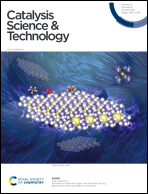Tuning the chemoselectivity of the Pd-catalysed hydrogenation of pyridinecarbonitriles: an efficient and simple method for preparing pyridyl- or piperidylmethylamines
Abstract
An effective method for the chemoselective, liquid-phase heterogeneous catalytic hydrogenation of some pyridinecarbonitriles [4-, 3- or 2-pyridinecarbonitrile (4PN, 3PN, 2PN)] to the corresponding pyridyl- or piperidylmethylamines over a Pd/C catalyst was developed. Using our process, not only can an adequate primary amine selectivity to the desired pyridine derivatives [4-, 3- or 2-(aminomethyl)pyridine (4PA, 3PA, 2PA)] be achieved, but it has also been proved to be effective for the selective preparation of piperidylmethylamines [4-, 3- or 2-(aminomethyl)piperidine (4PIPA, 3PIPA, 2PIPA)] by further hydrogenation of the pyridine ring in addition to the nitrile group. The essence of this method is that the synthesis can be fine-tuned by simply adjusting the amount of acidic additive (H2SO4) based on whether the product to be prepared is pyridyl- or piperidylmethylamine. Complete conversions were obtained under mild conditions (30–50 °C, 6 bar), in all cases, but the very high selectivity to 4PIPA or 4PA (98 and 93%, respectively) decreased to 76% (3PIPA) and 72% (3PA), as well as 10% (2PIPA) and 57% (2PA) by changing the position of the nitrile group in the pyridine ring. The possible reasons for the diverse primary amine selectivities observed in the hydrogenation of the constitutional isomers of pyridinecarbonitriles were confirmed by quantum chemical calculations (DFT). Adsorption energy profiles regarding the interactions between the nitrile starting materials, imine intermediates or amine products and palladium were computed to clarify the selectivity changes.



 Please wait while we load your content...
Please wait while we load your content...